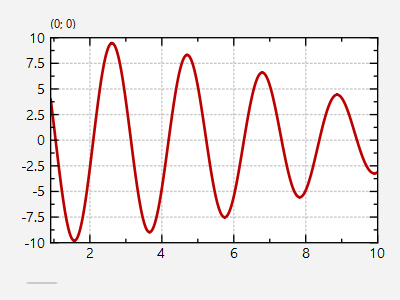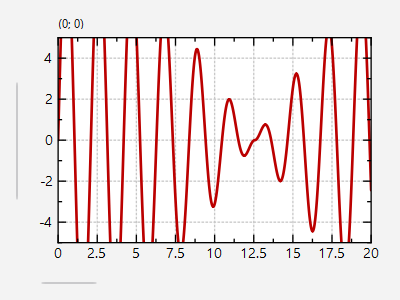| .. | ||
| CMakeLists.txt | ||
| README.md | ||
| ui_bind_scrollbar.cpp | ||
Example (JKQTPlotter): Using a QScrollbar together with JKQtPlotter
This project (see ./examples/ui_bind_scrollbar/) shows how to use JKQTPlotter together with a QScrollBar for panning.
The source code of the main application can be found in ui_bind_scrollbar.cpp.
First we create a QWidget, a plot and a QScrollBar in a layout:
QWidget win;
QVBoxLayout* lay=new QVBoxLayout();
win.setLayout(lay);
JKQTPlotter* plot=new JKQTPlotter(&win);
lay->addWidget(plot);
// add a QScrollBar below the plot
QScrollBar* scroll=new QScrollBar(Qt::Horizontal, &win);
scroll->setMinimum(0);
scroll->setMaximum(100);
scroll->setPageStep(10);
lay->addWidget(scroll);
Then we add a plot ranging from x=0 to x=100, with 10000 datapoints:
// 4. create a graph
JKQTPDatastore* ds=plot->getDatastore();
const int NPOINTS=10000;
JKQTPXYLineGraph* graph=new JKQTPXYLineGraph(plot);
const size_t colX=ds->addLinearColumn(NPOINTS, 0, 100, "x");
graph->setXColumn(colX);
graph->setYColumn(ds->addCalculatedColumnFromColumn(colX, [](double x) { return 10.0*sin(x*3.0)*fabs(cos((x/8.0))); }, "f(x)"));
graph->setDrawLine(true);
graph->setSymbolType(JKQTPNoSymbol);
// ... add the graphs to the plot, so it is actually displayed
plot->addGraph(graph);
The plot axis range is limited to the plot range and zooming in y-direction is disabled
plot->setAbsoluteXY(0,100,-10,10);
// show everything in y-direction
plot->setY(-10,10);
// fix y-range, so no zoming occurs in y
plot->getYAxis()->setRangeFixed(true);
Now we need a slot for the QScrollBar (here implemented as a functor), which calculates the desired view in the graph and sets it. Note the blockSignals()-calls that stop the plot from sending signals back to the scrollbar, which would cause a strange loop due to the fact that the scrollbar only accepts integers for range and value!
QObject::connect(scroll, &QScrollBar::valueChanged, [plot,scroll](int value) {
const double scrollRange=scroll->maximum()-scroll->minimum()+scroll->pageStep();
const double scrollPos=scroll->value();
const double scrollPageSize=scroll->pageStep();
const double scrollRelative=scrollPos/scrollRange;
const double plotFullRange=plot->getAbsoluteXMax()-plot->getAbsoluteXMin();
const double plotViewRange=scrollPageSize/scrollRange*plotFullRange;
const double plotViewStart=plot->getAbsoluteXMin()+scrollRelative*plotFullRange;
plot->blockSignals(true);
plot->setX(plotViewStart, plotViewStart+plotViewRange);
plot->blockSignals(false);
});
scroll->setValue(1); // ensure to call slot once!
A second functor catches whenever the user zooms or pans (or otherwise changes the axis ranges) of the plot by catching the signal JKQTPlotter::zoomChangedLocally() and from that calculates the value (and pageStep) for the QScrollBar:
QObject::connect(plot, &JKQTPlotter::zoomChangedLocally, [scroll](double newxmin, double newxmax, double newymin, double newymax, JKQTPlotter* plot) {
const double plotFullRange=plot->getAbsoluteXMax()-plot->getAbsoluteXMin();
const double plotViewRange=newxmax-newxmin;
const double plotRelViewRange=(plotViewRange>=plotFullRange)?1.0:(plotViewRange/(plotFullRange-plotViewRange));
const double plotRelViewStart=(newxmin-plot->getAbsoluteXMin())/plotFullRange;
const double scrollRange=scroll->maximum()-scroll->minimum();
scroll->blockSignals(true);
scroll->setPageStep(plotRelViewRange*scrollRange);
scroll->setValue(plotRelViewStart*scrollRange);
scroll->blockSignals(false);
});
The window from this example looks like this:
With the same method, it is also possible to add x- and y-scrollbars:

